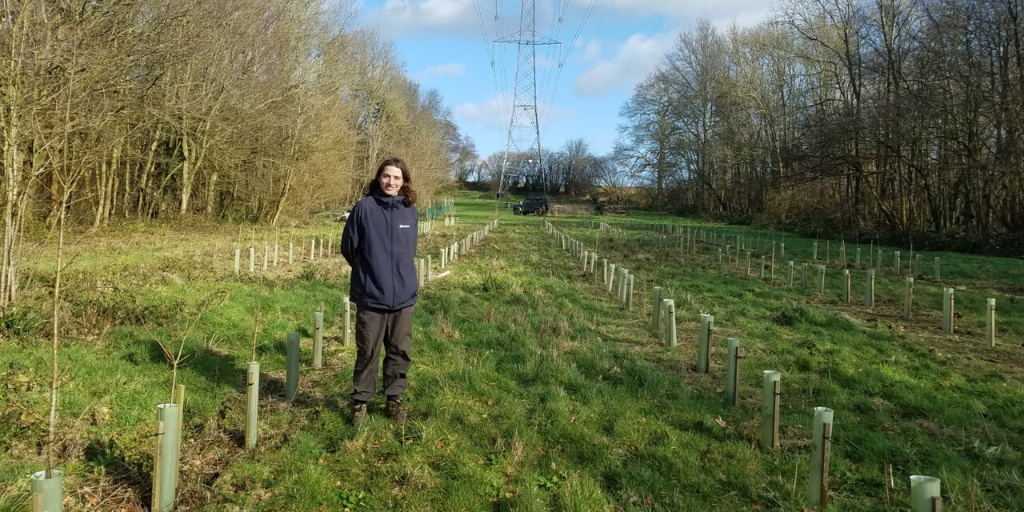My First Three Months at Future Trees Trust
A blog by Future Trees Trust Research Assistant Joe Beesley
Hello, my name is Joe and I joined Future Trees Trust at the start of the year. My role as Researcher is to assist our Head of Research, Jo Clark with visiting field trials, analysing data and sharing our findings.

I come from a BSc and PhD in Biochemistry at the University of Bristol and hope I can use my expertise to support and advance all the exciting projects ongoing at Future Trees Trust into tree improvement, genetics and health. In my first blog post I’m going to be talking about the work we’ve been doing in my first three months with the charity.
My first week was straight in at the deep end: a week of fieldwork in Oxfordshire, the New Forest and Windsor Great Park relocating oak plus trees with a crew of tree climbers.
Plus trees are dominant individuals in a stand that are healthy, have straight and circular stems, display good apical dominance and have little branching. We are climbing them to collect scions from the upper branches which will be grafted onto rootstocks and then planted out in seed orchards and conservation hedges. However, the features that make an ideal plus tree – tall, no branching – are those that make a tree more difficult to climb! Always up to the challenge, Richard from Hazelwood Tree Management and Rob from Oak Leaf Tree Services, scaled 15 trees over the week and we collected excellent material to send for grafting.
The grafted trees will primarily go into our oak clonal seed orchard programme (CSO) which is aiming to plant three orchards for each of the two species of oak native to the UK – Quercus robur (pedunculate oak) and Q. petraea (sessile oak). In these orchards the grafted plus trees will cross-pollinate and hopefully produce acorns that will grow into excellent timber trees.
.png)
After my busy first week it was up to Scotland to attend the annual birch group meeting. One of the longest running and accomplished species groups, the conversation at the meeting ranged from current seed production to the establishment of new trials and the identification of more silver birch plus trees in southern England.
Back down in Oxfordshire, we focused again on the oak CSO project. During the previous winter, tree climbers had been collecting scions from oak trees in East Anglia and successful grafts were now one year old and ready to be planted. There were several days of logistical head scratching as we worked out how to get trees from two nurseries to four sites all at opposite sides of the country. Eventually a plan was devised, and we set out. Our first stop was Kent and the nursery at East Malling Research. Here we picked up several hundred trees ready to be planted and were treated to a nice surprise. Fresh of the hot pipe were the calloused grafts from the scions we had sent from the fieldwork in my first week!
.png)
With trees in the van the first stop was one of our archive sites in Kent where oak plus trees of both species are being planted to conserve their genetics. The site will be managed as a hedge and soon will allow scion material to be collected far more easily than by tree climbing. While in Kent, we also made a stop at an ash trial where individuals that had been identified as tolerant to the fungal disease ash dieback were being further investigated. We collected scion material from trees that still appeared tolerant and those that were now infected to send to research partners as part of the DEFRA-funded Living Ash Project.
.png)
Next, we headed to Worcestershire to collect another set of oak grafts from Frank P Matthews and then on to Herefordshire and the National Forest to plant out the trees at two of our CSO sites. After a very wet winter the ground was still quite water-logged at the second site, but with a team of contractors we managed to plant all 212 trees in a single day. With a day in hand we headed home.
My first three months were rounded off by a trip to Paradise Wood, a 50 ha research woodland owned and managed by Earth Trust. Within this site are trials of ash, beech, cherry, oak and walnut that are investigating areas such as provenance selection, silviculture techniques and disease resistance. Walking around this fantastic woodland and seeing the progress of these diverse trials was a great way to finish off our season of fieldwork.
With the ongoing coronavirus outbreak, we were lucky to finish all of our fieldwork and are now working inside again – processing data, writing reports and planning site visits for later in the year. The first few months have been a fascinating whirlwind of fieldwork, meetings and new science. I’m grateful to be here and very much looking forward to seeing our trials and trees in leaf and in sunshine over the summer months.
Posted on the 6th May 2020 at 9:34am

Leave A Comment